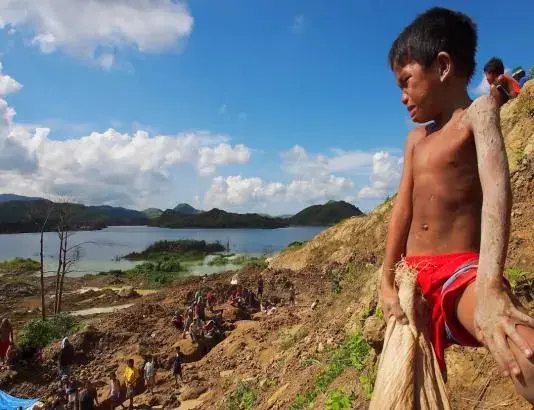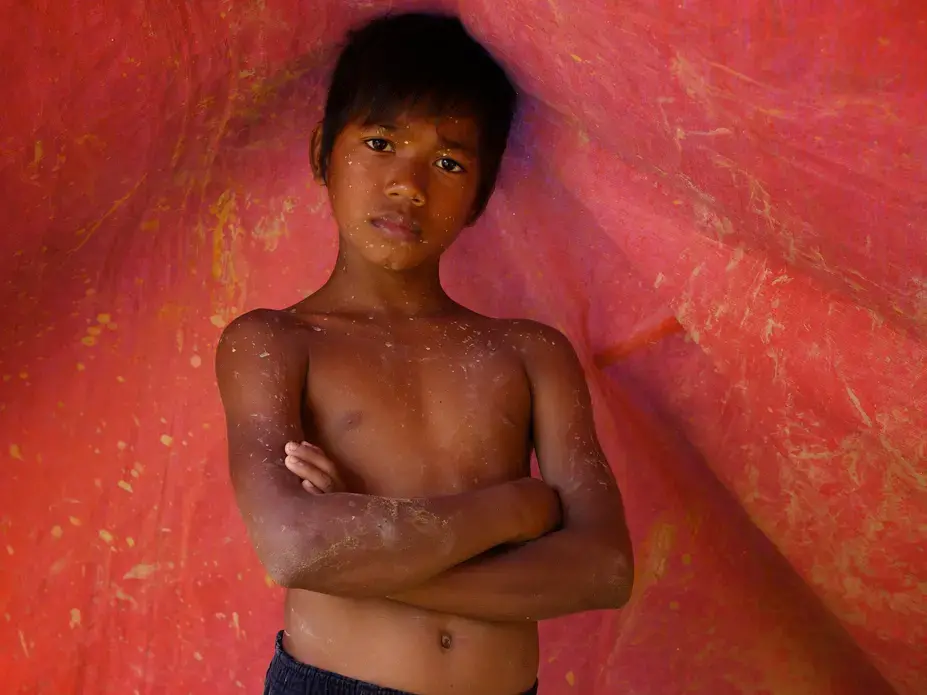The boy struggled up the hillside, climbing barefoot 150 feet above the mining pit in the valley below. Behind him he dragged a bag of ore. Only partly filled, the bag weighed 10, maybe 15 pounds – half the weight of the filled sacks other boys ahead of him carried. Fifty feet above him, the older boys yelled at him to hurry. The bag was too heavy for his thin, small shoulders and his arms ached from dragging it. He dropped his load and began to cry. He was just 4 years old.
The tiny boy I photographed on that hillside was one of dozens of children working at a small-scale mine in the jungle near Panique on the island of Masbate in the Philippines.
I had heard that children worked in the mines, but I never expected to see such small ones. Little girls and boys sat in shallow muddy water, panning for gold specks, while the older, stronger children – many younger than 10 years old – broke rocks with three-pound hammers or chipped away at the walls of the pits with mallets and rebar rods. Entire families were working frantically at this site to get as much ore as they could. They had learned the day before that a nearby industrial mining company, which owned the land, was about to bulldoze their pits to build a road.
It was a crazy scene, but a common one in the Philippines where those who are accustomed to hard work can pull gold from the earth.
The islands of the Philippines are rich in gold, producing more than 31 metric tons in 2011 to rank 18th in world production. More than half of that gold comes from small-scale mines. It is in these mines that you will find the children.
The International Labour Organization, which is working to end child labor, estimates that more than 18,000 women and children work in small-scale mines, though some experts believe the number is much higher. Child labor is against the law in the Philippines, but the law is rarely enforced, especially when mining is seen as a family affair. As the price of gold rises, the impetus for parents to put their children to work increases also.
As ILO representative Jesus Macasil explains, child labor is accepted because the families need the income. "The children are quite important," Macasil says. "They can carry the rock, process the minerals and when there is underground work, they can go into the very small tunnels where an adult would not fit."
Mining is considered one of the most dangerous forms of child labor. Children are at constant risk of injury and death from accidents. Even more pervasive and insidious are the risks of long-term and often devastating health problems. The children suffer lung damage caused by breathing dust and particulates, muscular and skeletal damaged caused by carrying heavy loads, and worst of all, a range of neurological problems caused by exposure to mercury, which is used to separate the gold from the rock.
Panning with mercury pollutes the watershed and can contaminate food supplies; burning gold ore with mercury releases toxic fumes. Children, who are enlisted to purchase mercury and bring it back to the mines, regularly handle mercury. The parents seem unaware of these dangers. Some that I talked with were proud that their very young children could perform such hard labor so well. When I asked one woman if her daughter, a little girl in a dress expertly panning in the stream, was 5 or 6 years old, the mother corrected me, saying, "No, she's 4!"
Dangers Underground
The teenagers who labor in the deep mines often "lie up" about their ages. Officially, minors aren't permitted underground, but at a mine near the village of Syndicate on the island of Masbate, I saw apprentices who appeared to be no more than 15 or 16 years old. When I'd ask about their ages, they'd snicker and say "21," but always someone else would chime in, "He's 16 or he's 18."
Air is pumped into these deep mines through small pipes attached to compressors on the surface. Sump pumps remove ground water from the shafts. As I climbed down into one of these shafts, I heard shouting and the sound of splashing water. The sump pump had broken and the water was rising rapidly. Men and boys stood in chilly water up to their necks, the ceiling of the cavern just above their heads, working methodically and calmly to repair the broken pump. One of the teenagers was still sampling the rock just above the water line. They fixed the pump, the water receded and they kept working, as though nothing had happened.








